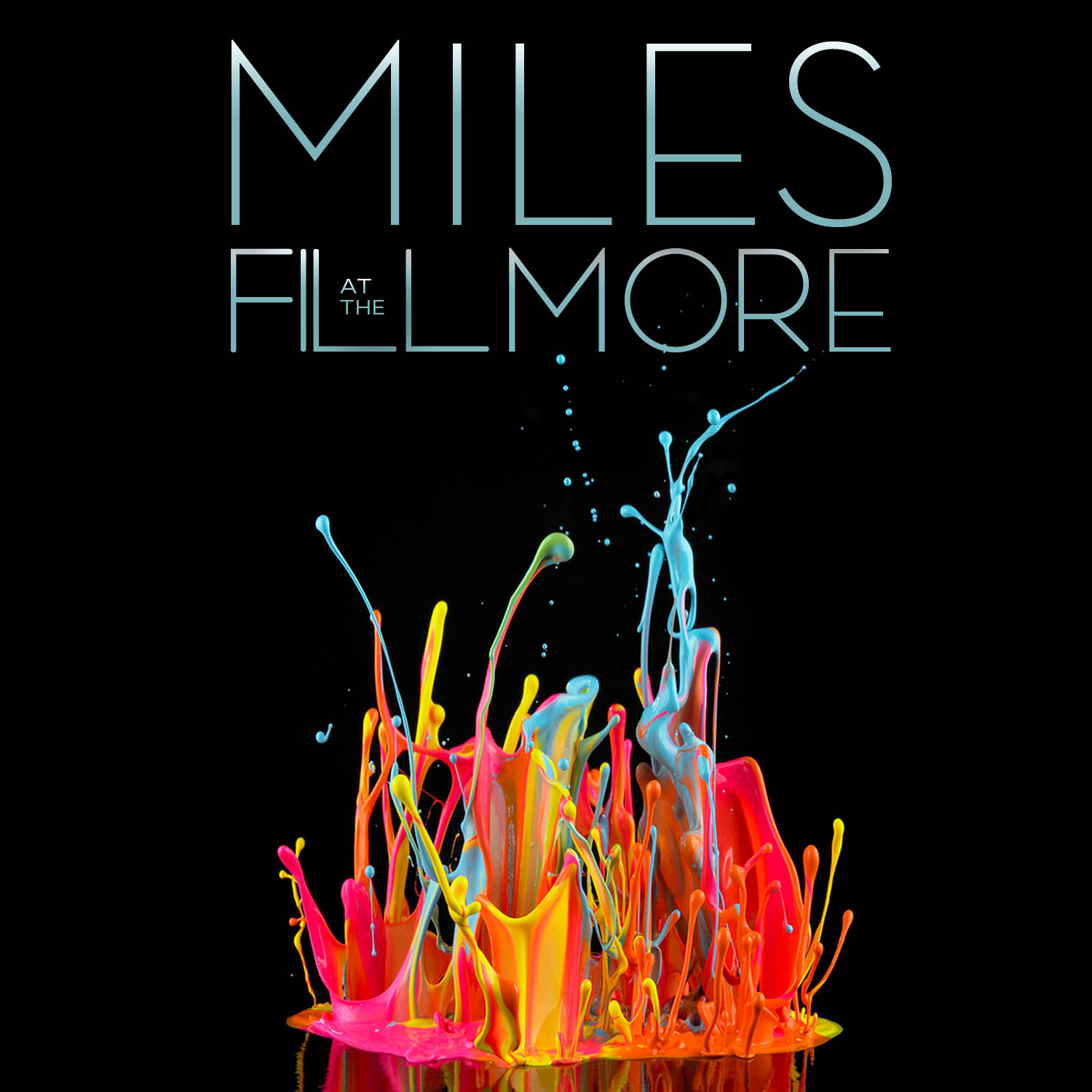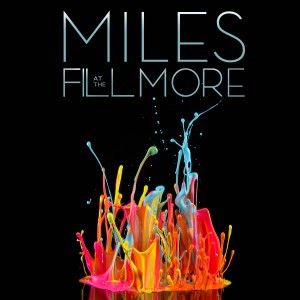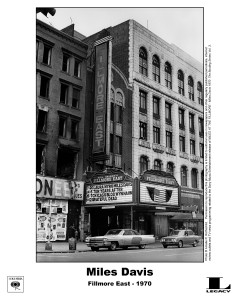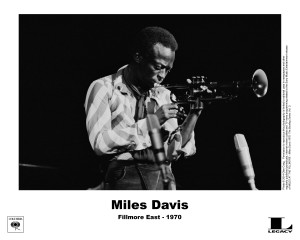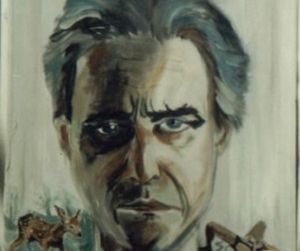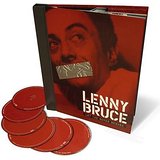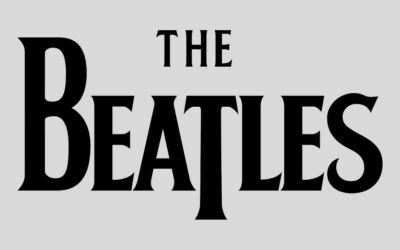Miles Davis 1970: The Bootleg Series Vol. 3
By Harvey Kubernik c 2014
Miles Davis’ historic four-night stand at promoter Bill Graham’s legendary Fillmore East in New York City, June 17-20, 1970, is presented in its entire full-length
unedited form for the first time as Miles At The Fillmore-Miles Davis 1970: The Bootleg Series Vol. 3
The four-CD box set is available through Columbia/Legacy, a division of Sony Music Entertainment.
The long-awaited document contains over two hours of previously unissued music, including bonus tracks recorded at Fillmore West in San Francisco.
The 1970 Miles Davis band compromised Davis, Chick Corea, Keith Jarrett, Dave Holland, Jack DeJohnette, Airto Moreira, and Steve Grossman,
At one of the most crucial moments in jazz and rock history, two months after the release of Miles’ groundbreaking double-LP Bitches Brew in April 1970, he was beginning to discover – and be discovered by – the burgeoning rock audience that came of age in the late 1960s. Miles, inducted into the Rock And Roll Hall Of Fame in 2006, the only jazz artist and only solely instrumental artist ever inducted, had started listening to the funk of James Brown, Sly & the Family Stone, the Chambers Brothers, and Jimi Hendrix, not to mention the Beatles. Bitches Brew was a turning point for jazz and rock.
Promoter Bill Graham had a long history of presenting jazz artists at the Fillmores (Charles Lloyd, John Handy, and Roland Kirk among them) and Miles also carried rock audiences into the new plateau and demographic.
“The Bay area is a conglomeration of professional rejects from the rest of the world, actors, who couldn’t make it, dancers who couldn’t make it,” entrepreneur Graham underscored to me during a 1976 interview at his Mill Valley house in California.
“There was never a San Francisco sound, or a Boston sound. They may do the same thing to an audience though, which is give them pleasure.
“I think I have some idea about music and what the streets are all about, and about what downtown is all about. I was a New York energy freak to some extent, and I still am. We want to turn people on and we want them to have a good time. That’s the dilemma a musician has. A musician may think he played a shit set, and the audience out there is going crazy.”
In October 1970, Columbia Records released the 2-LP set Miles Davis At Fillmore, which consisted of performances culled from the four nights of shows at the Fillmore East (where Miles opened for fellow Columbia artist Laura Nyro).
At that time the shows were edited to fit the LP format. The full unedited shows are now presented for the first time yielding 100-plus minutes of previously unreleased music.
The three additional bonus tracks add another 35 minutes of music, released here for the first time, recorded in April 1970, at the Fillmore West in San Francisco (where Graham put Miles and band on a bill with the Grateful Dead and Stone the Crows). The 2014 edition has 135 minutes of previously unreleased music.
The 32-page booklet in the package incorporates a 2,500-word chronologic essay written by reissue producer Michael Cuscuna, who was a first-hand witness (as a disc jockey on New York’s influential WPLJ-FM) to Miles’ development at the time.
There is also an introductory Producers’ Note written by reissue producers Cuscuna and Richard Seidel. They provide a concise overview of Miles’ Fillmore period and the project itself, its correlation with the original Columbia double-LP, especially the additional 100 minutes of unreleased music from the shows, and 35 minutes of unreleased music on the bonus tracks.
With the release of his groundbreaking double-LP Bitches Brew on Columbia just two months earlier in April 1970, Miles was front-page news around the world. He was leading a quintet lineup that included Chick Corea on electric piano, bassist Dave Holland, and drummer Jack DeJohnette (all of whom had been at the core of the Bitches Brew sessions recorded in August 1969), plus two members who had played on studio sessions since November, 1969 and then joined the touring band in February and April of 1970 respectively – tenor and soprano saxophonist Steve Grossman, and percussionist, flutist and vocalist Airto Moreira.
At the Fillmore East, they were joined by Keith Jarrett on organ and tambourine, during the historic three month period when both Jarrett and Corea manned the keyboards for Miles. Jarrett had just played on some key Miles studio sessions in the weeks before the Fillmore East shows, and would continue to be a member of the band until late 1971, also performing on Miles’ remaining two Fillmore stints – at Fillmore West in October 1970, and May 1971.
The four-CD box set devotes one disc to each of the four nights that Miles and his group performed at the Fillmore East. As issued on the original Columbia double-LP in 1970 (Miles Davis At Fillmore, currently available on double-CD as C2K 65139) the music, whose original set lengths ranged from 46 minutes to nearly one hour, was edited by producer Teo Macero to accommodate a seamless sampling of music from each night on each of the four LP sides.
In a rare, in-depth 1970 interview for rock magazine Zygote, it was reported that Miles, while listening to the concert playback, was “so excited about the music that he wanted every set, every note made available to the public.”
“Miles always saw performance in terms of a canvas – both audio and visual,” observes author and record producer, Kenneth Kubernik. “It was not surprising, therefore, that the latter part of his life was focused on painting. Live at Fillmore finds him in his cubist phase; the music, a melange of swing, electric blues, funk and pure abstraction, is seen and heard as if through a shattered mirror. Dueling keyboard giants Keith Jarrett and Chick Corea serve up huge swaths of sonic primer, allowing the cross-hatched banshee wails of Davis and saxophonist Steve Grossman to menace. It is both coruscating and subterranean, a journey into the heart of great artists battling their own finely-honed instincts. It is timeless and utterly out of time. It will clear a room and end a romance – genius on the razor’s edge.”
For 2014’s Miles At The Fillmore-Miles Davis 1970: The Bootleg Series Vol. 3, the producers returned to the original remote live recording tapes, produced by Macero and engineered by Stan Tonkel.
On each of the four nights, Miles and his group shook the rafters with high-volume performances of four staples (and the half-minute closer, “The Theme”): “Directions” (which he first recorded in the studio in November 1968, and played every night from 1969 to ’71, but was not issued on record until 1980); “The Mask” (a new composition that Miles recorded two weeks before these Fillmore East shows, at the tail end of the four-month long Jack Johnson sessions); “It’s About That Time” (from the In A Silent Way album of early 1969); and “Bitches Brew” (lean and muscular versions in the 10 to 14-minute range, that did not sacrifice any of the funk power of the original 27-minute album version, probably the first Miles record purchased by most of the Fillmore rock fans).
As Miles and the Fillmore East audiences warmed up to each other, and the sets grew to nearly an hour in length, additional tunes were heard. On the second night, Miles played an encore (an extremely rare occurrence), “Spanish Key” from Bitches Brew. On both the third and fourth nights, Miles followed up “It’s About That Time” with the same two songs: the World War II evergreen “I Fall In Love Too Easily” (associated with Frank Sinatra, recorded by Miles on 1963’s Seven Steps To Heaven) and the Wayne Shorter composition “Sanctuary” (from Bitches Brew). On the fourth night, Miles added “Willie Nelson,” which he had recorded in February at the start of the Jack Johnson sessions.
For the bonus tracks, the producers judiciously chose three songs from the April 1970 Fillmore West shows that were in the band’s repertoire, but were not performed at the Fillmore East in June. On disc one, “Wayne Shorter’s ‘Paraphernalia’ and ‘Footprints’,” the producers note, “are from the earlier acoustic repertoire and Miles was to soon stop per¬forming them.” (In fact, “Paraphernalia” dates from 1968’s Miles In the Sky, and “Footprints” dates from 1966’s Miles Smiles.) On disc three, a 13-minute live version of the Jimi Hendrix-influenced “Miles Runs The Voodoo Down” rivals the 14-minute original on Bitches Brew.
Davis’ March 1970 Fillmore East shows were recorded on a four-track tape machine and the April ’70 Fillmore West dates on 8-track. So the San Francisco material is much more vivid, much more dimensional and much more detailed.
To some avid Miles Davis record collectors, there was always a little bit of the sense, owing to the edited format, that with the original LP version of these shows you were getting teased or cheated with the Miles at Fillmore LP in 1970. The new configuration helps completes the puzzle. It lets us hear that the majestic ebb and flow on the album Back Beauty was not just a fluke. Because that’s the only other concert recording of this band.
“The contrast between the edited versions of these concert recordings that appeared on the Columbia 1970 double-LP release and the full measure this 4-CD set provides is very enlightening,” explains DJ Dr. James Cushing of KCPR-FM.
“The edited versions always sounded more than a little chaotic to me, so I’m grateful to hear each complete set unfold organically, which reveals the music’s continuity.
Sticking pretty much to the same set-list each show, Miles turns each evening into a two-tiered drama involving his trumpet and Steve Grossman’s saxophone and, at another level, the dueling keyboards of Chick Corea and Keith Jarrett. The two interacting horns and keyboards suggest the spectrum of Davis’ whole career. Grossman takes the Bird/Trane/Mobley/Shorter role of the long-winded saxophonist complementing Miles’ pithy trumpet, but the Corea/Jarrett team look forward to the electronic future,” Cushing observes.
“The rhythm section of Dave Holland (bass) and Jack DeJohnette (drums) is the secret hero of the band, with all the power this loud, exciting music needs and with all the flexibility it demands. Surely the Miles Davis 1970: The Bootleg Series Vol. 3 has reached a new high”
In the April 2014 issue of UNCUT magazine, writer and author Richard Williams in his review of the Miles Davis Fillmore 1970 expanded reissue aptly describes the action captured on these discs. “As an ensemble, the musicians could swerve and drift with a deceptively offhand fluency through their repertoire-a nightly permutation from ‘Sanctuary,’ ‘Directions,’ ‘Miles Runs The Voodoo Down,’ ‘Bitches Brew,’ ‘Spanish Key,’ ‘It’s About That Time,’ ‘Footprints,’ and an unexpected nod to former glories in the ballad, ‘I Fall In Love Too Easily’-to create a series of mood-platforms on which their employer could display every facet of his genius, from squally high-note explorations to pensive balladry.”
A quintessential Renaissance Man, Miles Davis continues to break records as the U.S. Postal Service’s most successful and fastest-selling stamp in recent years, with more than 23 million sold.
The filmic spotlight is currently on Miles Davis, with the 2014 announcement of his biopic going into production this June, starring Don Cheadle, Ewan McGregor and Zoe Saldana.
(A portion of this article was previously published in Record Collector News).
Santa Monica Press in April 2014 published Harvey Kubernik’s acclaimed coffee table book, Turn Up The Radio! Rock, Pop and Roll in in Los Angeles 1956-1972. Introduction penned by Tom Petty, afterward from Roger Steffens.
Otherworld Cottage Industries during February 2014 published Harvey Kubernik’s book It Was Fifty Years Ago Today The Beatles Invade America and Hollywood. In September of 2014, Palazzo Editions will publish Leonard Cohen: Everybody Knows, a narrative and oral history written by Kubernik.
Harvey Kubernik and Kenneth Kubernik have written the text and biographical portrait for legendary photographer Guy Webster’s first book of music, movie and television photos for Insight Editions. Big Shots: Rock Legends & Hollywood Icons: Through the lens of Guy Webster. To be published on October 14, 2014. Introduction by Brian Wilson.

